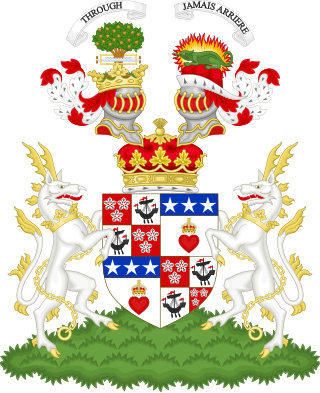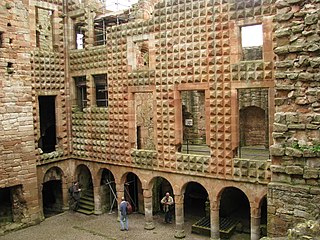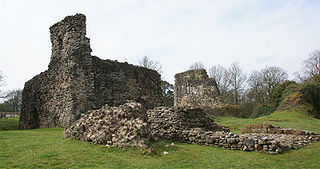Related Research Articles
James Hamilton, 1st Earl of AbercornPC (S) (1575–1618), was a Scottish diplomat for James VI and an undertaker in the Plantation of Ulster in the north of Ireland.

Robert II was King of Scots from 1371 to his death in 1390. The son of Walter Stewart, 6th High Steward of Scotland, and Marjorie, daughter of King Robert the Bruce, he was the first monarch of the House of Stewart. Upon the death of his uncle David II, Robert succeeded to the throne.

Duke of Hamilton is a title in the Peerage of Scotland, created in April 1643. It is the senior dukedom in that peerage, and as such its holder is the premier peer of Scotland, as well as being head of both the House of Hamilton and the House of Douglas. The title, the town of Hamilton in Lanarkshire, and many places around the world are named after members of the Hamilton family. The ducal family's surname, originally "Hamilton", is now "Douglas-Hamilton". Since 1711, the dukedom has been held together with the Dukedom of Brandon in the Peerage of Great Britain, and the dukes since that time have been styled Duke of Hamilton and Brandon, along with several other subsidiary titles.

Walter Scott, 5th of Buccleuch, 1st Lord Scott of Buccleuch was a Scottish nobleman and famous border reiver, known as the "Bold Buccleuch" and leader of Kinmont Willie's Raid.

David Lindsay, 1st Earl of Crawford was a Scottish peer who was created Earl of Crawford in 1398.

Clan Cranstoun is a family of the Scottish Lowlands.

Clan Oliphant is a Highland Scottish clan.
Patrick II (1185–1249), called "6th Earl of Dunbar", was a 13th-century Anglo-Scottish noble, and one of the leading figures during the reign of King Alexander II of Scotland.
William Cranstoun, 3rd Lord Cranstoun was a Scottish Lord of Parliament and a renowned Cavalier.
Robert Lauder of The Bass was an important noble in Haddingtonshire, the Merse, and Fife. Stodart remarks that "to 1600 the barons of the Bass sat in almost every parliament". He was a firm supporter of Mary, Queen of Scots whom he accompanied to Carberry Hill on 14 June 1567, and fought for at the battle of Langside.
George Gordon, 2nd Earl of Huntly was a Scottish nobleman and Chancellor of Scotland from 1498 to 1501.
Euphemia Stewart, Countess of Strathearn was a medieval Scottish noblewoman, the daughter of David Stewart, Earl Palatine of Strathearn and Caithness. She succeeded to both her father's titles after his death between 1385 and 1389, probably March 1386.
William Douglas, 1st Marquess of Douglas and 11th Earl of Angus (1589–1660) was a Scottish nobleman.

Francis Stewart, 5th Earl of Bothwell, was Commendator of Kelso Abbey and Coldingham Priory, a Privy Counsellor and Lord High Admiral of Scotland. He was a notorious conspirator who led several uprisings against his first cousin, King James VI, all of which ultimately failed, and he died in poverty in Italy after being banished from Scotland. Francis's maternal uncle, the 4th Earl of Bothwell, was the chief suspect in the murder of James VI's father, Lord Darnley.

Lochmaben Castle is a ruined castle in the town of Lochmaben, the feudal Lordship of Annandale, and the united county of Dumfries and Galloway. It was built by Edward I in the 14th century replacing an earlier motte and bailey castle, and later rebuilt during the reign of James IV of Scotland. The earlier motte-and-bailey castle was built south of the current castle in c. 1160 by the Bruce family, Lords of Annandale.
Janet Beaton, Lady of Branxholme and Buccleugh (1519–1569) was an aristocratic Scottish woman and a mistress of James Hepburn, Earl of Bothwell. She had a total of five husbands. One of her nieces was Mary Beaton, one of the four ladies-in-waiting of Mary, Queen of Scots, known in history as the four Marys. In her lifetime, she was accused of having been a witch. Janet was immortalised as Sir Walter Scott's Wizard Lady of Branxholm in his celebrated narrative poem "Lay of the Last Minstrel".
Alexander Gordon, 3rd Earl of Huntly was a Scottish nobleman. He was a member of Parliament, a member of the Privy Council, a regent and Lieutenant of the kingdom.
John Cranstoun, 2nd Lord Cranstoun was a Scottish Lord of Parliament.
Dunbar Hamilton Douglas, 4th Earl of Selkirk FRSE was a Scottish peer.
Sir Richard Preston, 1st Earl of Desmond was a favourite of King James VI and I of Scotland and England. In 1609 the king made him Lord Dingwall. In 1614, he married Elizabeth Butler, the only child of Black Tom, the 10th Earl of Ormond, and in 1619 he was created Earl of Desmond.
References
- 1 2 3 4 5 Sir John Balfour Paul, The Scots Peerage , volume II (David Douglas, Edinburgh, 1905), at pages 592–593
- ↑ Mark Netzloff, England's Internal Colonies (Palgrave Macmillan, 2003), at page 144
- ↑ Peter Hume Brown, History of Scotland, volume VI
- ↑ Joseph Foster, Members of Parliament, Scotland, including the minor barons (Hazell, Watson and Viney, 1882), at page 81
- ↑ Melros Papers, vol. 1 (Edinburgh, 1837), pp. 80–3.